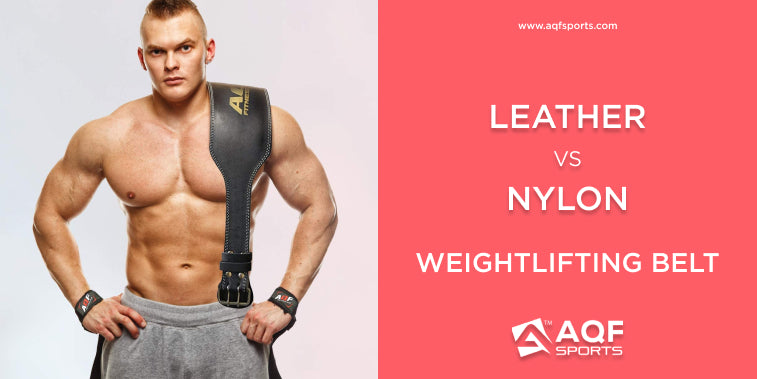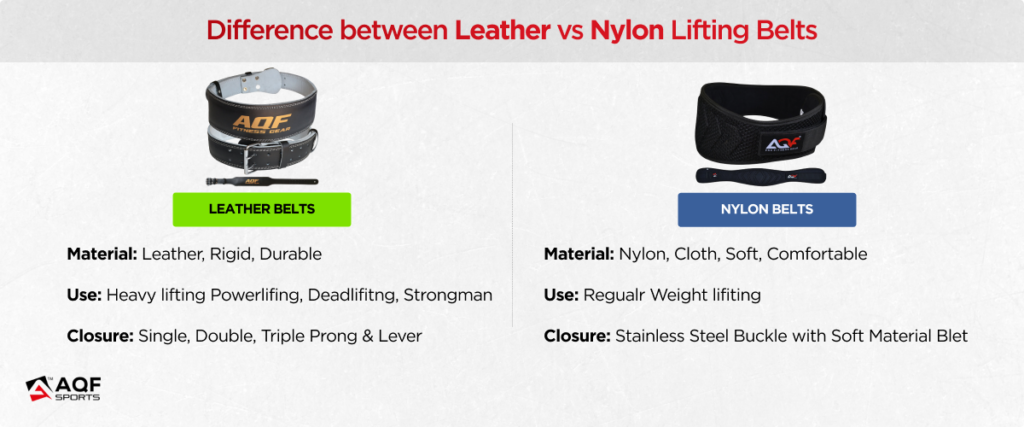Leather vs Nylon Lifting Belt! How to Choose the Right One?

Leather and nylon belts may look similar at first glance. But are they the same? Before investing in your efforts, it is important to know how they differ, and which will meet your expectations.
In this blog post, we will discuss all you need to know about leather vs nylon lifting belts to choose which is the best for you.
Leather weightlifting belts
Leather weightlifting belts are the most reliable weightlifting belts. These lifting belts are famous because of their durable design. Leather belts are well-built to support the heaviest of lifts. The thick leather makes it sturdier to support great pressure and resistance. Leather belts propagate the force evenly around your core and support your lower back during squats and deadlift workout sessions.
-

AQF Weight Lifting Cowhide Leather Belt 4″ Black
Available in S,M,L,XL,2XL & 3XL
£25.99
Buy Now
Pros and Cons of Leather Weightlifting Belts
Pros
- A product made of leather is more durable and reliable than most other materials. The leather belt is up to 13 mm thick and 4 inches wide, which makes it ideal for heavy-weight exercises without the risk of tearing.
- The leather belt is the best choice for performing deadlifts. It provides the needed support to the core to prevent lower back hyperextension while enduring a great amount of resistance.
- According to a study published in National Center for Biotechnology Information, wearing a belt that supports your core during weightlifting increases intra-abdominal pressure by up to 40%, and the compression of intervertebral discs reduces by 50%.[1]
Cons
- The main problem with leather belt design is the fact that it can be uncomfortable to wear. Because it is made of tough and durable leather, which makes the movements uneasy.
- A leather lifting belt inhibits a greater range of motions and especially for beginners the belt messes with their motor learning skills.[2]
- A leather lifting belt is expensive because of the material used in it and the high production costs.
Nylon Weightlifting Belts
Nylon weightlifting belts are famous for the comfort they provide during lifts. Nylon belts are great for Olympic weightlifting because they provide enough support to the core without adding any extra pressure. Nylon weightlifting belts are also recognised due to the vast assortment of closure systems it provides to select the best belt according to your weightlifting preferences.
Pros and Cons of Nylon Weightlifting Belts
Pros
- A nylon weightlifting belt is considered a good starting point for beginners due to the comfort it provides during lifting because of its soft material.
- The belt easily contours to the shape of your body allowing you a greater range of motions without pain or rigidity.
- It offers several closure systems like Velcro and buckles, and the nylon belt comes in a wide variety of designs, shapes, and sizes.
Cons
- The Velcro is not long-lasting and reliable when you use it consistently for heavy weights.
- The nylon lifting belts do not provide great support to the core and lower back as compared to the leather lifting belts.
- The greatest risk of nylon lifting belts is the fact that they are prone to rip or break during deadlifts and squats putting you in the danger of a distressing injury.
The Difference Between Leather vs Nylon Lifting Belts
Material and Construction
The leather lifting belt is made of several layers of leather, enclosed in a single or double stitching that makes it durable and stable for heavy weightlift workouts. The leather belt is thicker and more rigid.
Whereas the nylon lifting belt is more flexible and has a thinner material that sits comfortably on the lifter’s torso. The nylon lifting belts come in a variety of styles and varied stitching patterns.
Impact on Performance
A leather belt is stiffer and provides more rigid support to the lifter’s core. This rigidity can help the lifter maintain proper form and prevent excessive spinal flexion during heavy lifts. However, some lifters may find that a leather belt restricts their mobility and limits their range of motion, which can negatively impact their lifting performance.
On the other hand, a nylon belt is more flexible and allows for greater range of motion. A nylon belt does not provide as much core support as a leather belt. It can lead to a less stable lifting posture and increased risk of injury. Nylon belts are suitable for light training sessions.
Comfort
Leather belts are stiffer and do not need to be adjusted over and over during lifting sessions. Some lifters find leather belts too restrictive, limiting their range of motion. If you are wearing a leather belt for the first time, you may experience discomfort and stiffness in your lower back and hips.
On the other hand, nylon belts are generally more flexible and allow for greater range of motion. They are softer and more comfortable to wear during extended lifting sessions. They are lighter in weight and offer increased breathability to reduce sweating and overheating during workouts.
Fitting Adjustability
Due to their stiff material, leather belts are difficult to adjust to the lifter’s body shape. They take time to adapt to your body’s fitting. It’s important to choose the right size and shape of leather belt to ensure a snug fit. A poorly fitted leather belt is uncomfortable and limits range of motion.
Nylon belts, on the other hand, are more flexible and easier to adjust to the lifter’s body shape. They are lightweight, stretchable and easily conform to the lifter’s waist.
Pro Tip: Wider and thicker belts provide more support for your core, regardless of the material.
Buckle System
The leather belt comes in three options, single-prong, double-prong, and levers. Triple-prong leather belts are also available. The buckles and prongs are made of stainless steel making them durable and persistent. The pronged belt’s end has pre-made holes that can be adjusted easily, and the lever buckles are pre-fixed and tailored to your fit.
The nylon belts also have stainless steel buckles, the straps are either made of pure nylon or a cloth bend and can be easily adjusted to the torso. There are no pre-made holes and the nylon belt can be pulled tighter because of the soft material used. Nylon belts differ in rigidity levels following the belt width and straps.
The Use
Mostly, the powerlifters, weightlifters, and strongman competitors opt for the leather lifting belts because of the strong support and stability it provides to the core. Athletes consider the powerlifting organizations also while selecting the types of equipment. Usually, no more than a 13 mm thick belt is allowed.
The nylon lifting belts as compared to the leather belts are flexible and versatile. Nylon belts are for dynamic lifters like those in CrossFit, recreational lifting, and functional, and fitness athletes. A nylon belt is also a good weightlifting option for beginners because it provides ample support without inhibiting the movements.

Cost
Leather belts are more expensive than nylon belts due to the premium leather materials and high manufacturing cost. A high-quality leather belt costs anywhere between $50 and $200.
Nylon belts, on the other hand, are less expensive than leather belts. You can get a good-quality nylon for a price between $30 and $70.
Durability and Maintenance
Due to their sturdy material, leather belts are more durable than nylon belts. They can withstand heavy lifting wear and tear and last for many years.
Clean and condition your leather belt regularly to prevent the material from cracking and getting stiffer. Use a damp cloth and saddle soap to wipe leather belts after each use. Get a leather conditioner to keep your leather belt supple and flexible.
Nylon belts are made from less sturdy material and do not last as long as leather belts. You may need to get a new nylon belt every now and then. .
Keep your nylon belt clean and free from sweat and bacteria. You can wash your Nylon in a washing machine on a gentle cycle followed by air drying. Avoid exposing nylon belts to high heat or direct sunlight to protect nylon material.
Final Word
Choosing a leather or nylon weightlifting belt depends on your preferences. If you are into deadlifts, squats, and heavy weightlifting exercises you might want to opt for leather lifting belts. The extra stability it provides will help you throughout your heavy lifting sessions.
If you are a beginner a nylon belt will work for you, because of the comfortable material it allows you to make dynamic movements easily.
Reference:
[1]https://pubmed.ncbi.nlm.nih.gov/2709981/
[2]https://breakingmuscle.com/weightlifting-belts-should-you-use-one-pro-and-con/
Also Read:






